FORD CONTOUR 1999 2.G Owners Manual
Manufacturer: FORD, Model Year: 1999, Model line: CONTOUR, Model: FORD CONTOUR 1999 2.GPages: 244, PDF Size: 2.26 MB
Page 141 of 244
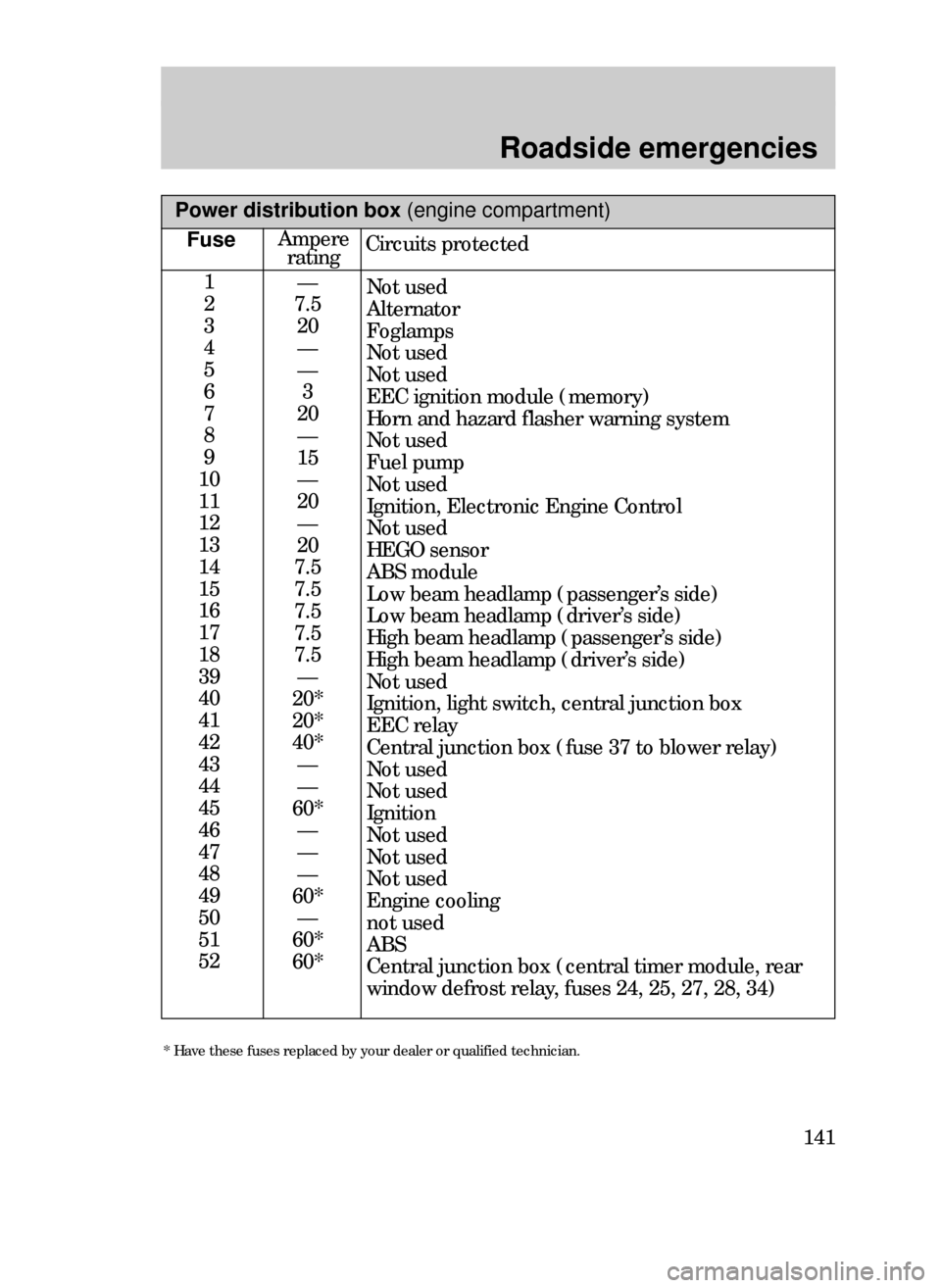
Roadside emergencies
141
Ampere
ratingCircuits protected
1
2
3
4
5
6
7
8
9
10
11
12
13
14
15
16
17
18
39
40
41
42
43
44
45
46
47
48
49
50
51
52Ñ
7.5
20
Ñ
Ñ
3
20
Ñ
15
Ñ
20
Ñ
20
7.5
7.5
7.5
7.5
7.5
Ñ
20*
20*
40*
Ñ
Ñ
60*
Ñ
Ñ
Ñ
60*
Ñ
60*
60*Not used
Alternator
Foglamps
Not used
Not used
EEC ignition module (memory)
Horn and hazard flasher warning system
Not used
Fuel pump
Not used
Ignition, Electronic Engine Control
Not used
HEGO sensor
ABS module
Low beam headlamp (passengerÕs side)
Low beam headlamp (driverÕs side)
High beam headlamp (passengerÕs side)
High beam headlamp (driverÕs side)
Not used
Ignition, light switch, central junction box
EEC relay
Central junction box (fuse 37 to blower relay)
Not used
Not used
Ignition
Not used
Not used
Not used
Engine cooling
not used
ABS
Central junction box (central timer module, rear
window defrost relay, fuses 24, 25, 27, 28, 34)Fuse
Power distribution box (engine compartment)
* Have these fuses replaced by your dealer or qualified technician.
23CREen 3/25/99 3:35 PM Page 141
Page 142 of 244
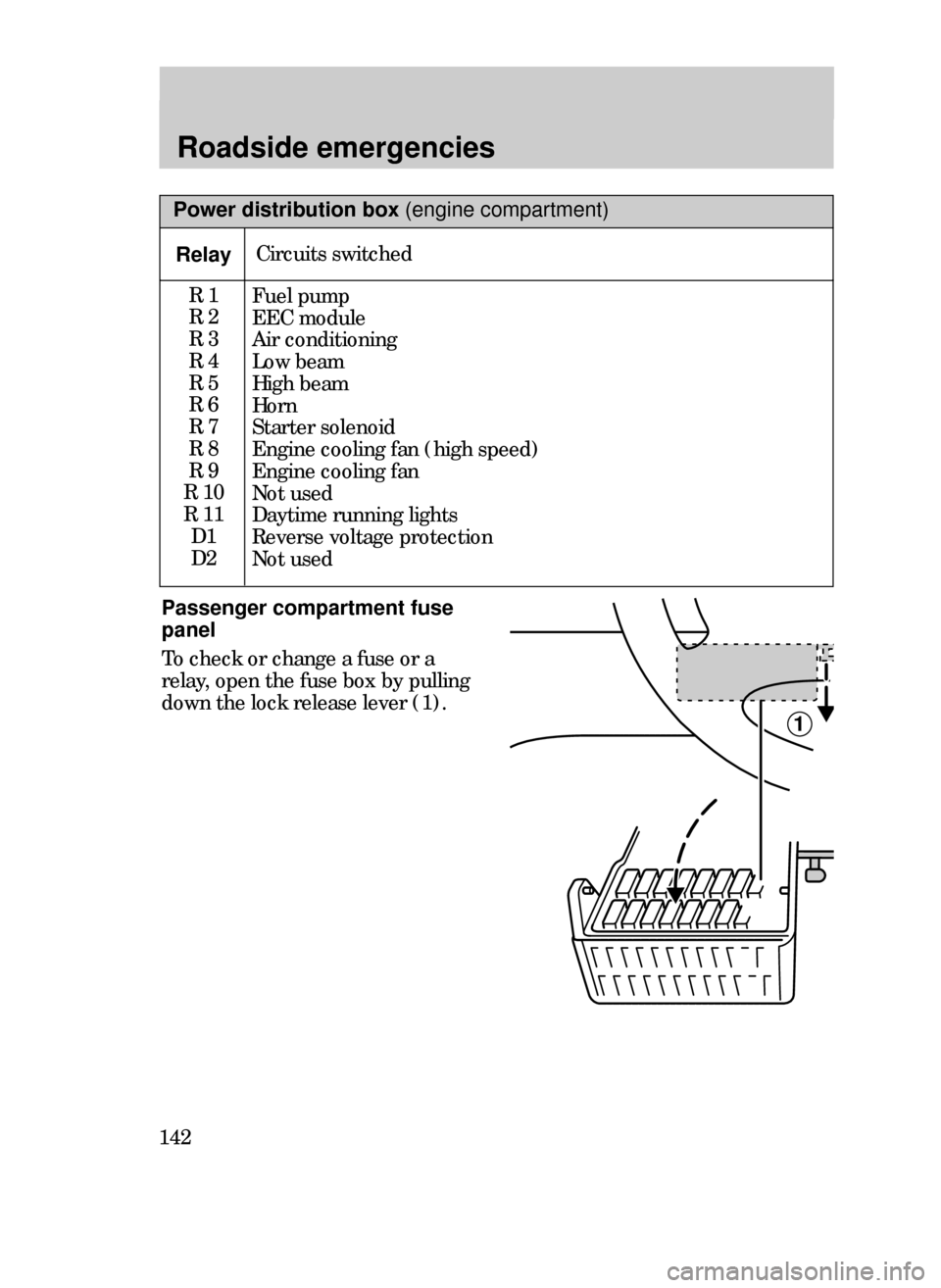
Roadside emergencies
142
Power distribution box (engine compartment)
RelayCircuits switched
R 1
R 2
R 3
R 4
R 5
R 6
R 7
R 8
R 9
R 10
R 11
D1
D2
Passenger compartment fuse
panel
To check or change a fuse or a
relay, open the fuse box by pulling
down the lock release lever (1).
1
Fuel pump
EEC module
Air conditioning
Low beam
High beam
Horn
Starter solenoid
Engine cooling fan (high speed)
Engine cooling fan
Not used
Daytime running lights
Reverse voltage protection
Not used
23CREen 3/25/99 3:35 PM Page 142
Page 143 of 244
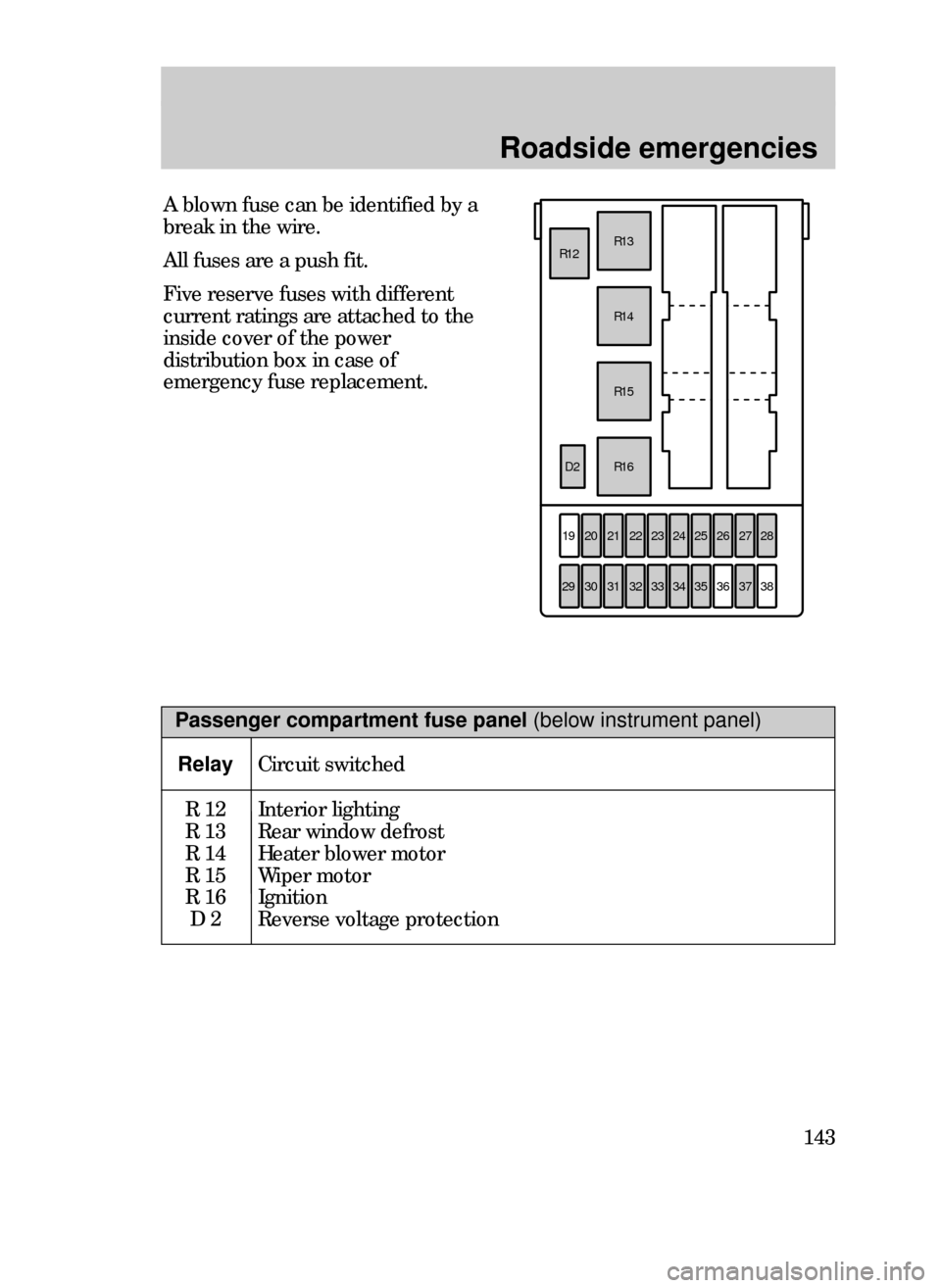
Roadside emergencies
143
A blown fuse can be identified by a
break in the wire.
All fuses are a push fit.
Five reserve fuses with different
current ratings are attached to the
inside cover of the power
distribution box in case of
emergency fuse replacement.
19 20 21R16 R15
R14 R12R13
22 23 24 25 26 27 28
29 30 31 32 33 34 35 36 37 38
D2
Passenger compartment fuse panel (below instrument panel)
Relay
Circuit switched
R 12
R 13
R 14
R 15
R 16
D 2Interior lighting
Rear window defrost
Heater blower motor
Wiper motor
Ignition
Reverse voltage protection
23CREen 3/25/99 3:35 PM Page 143
Page 144 of 244
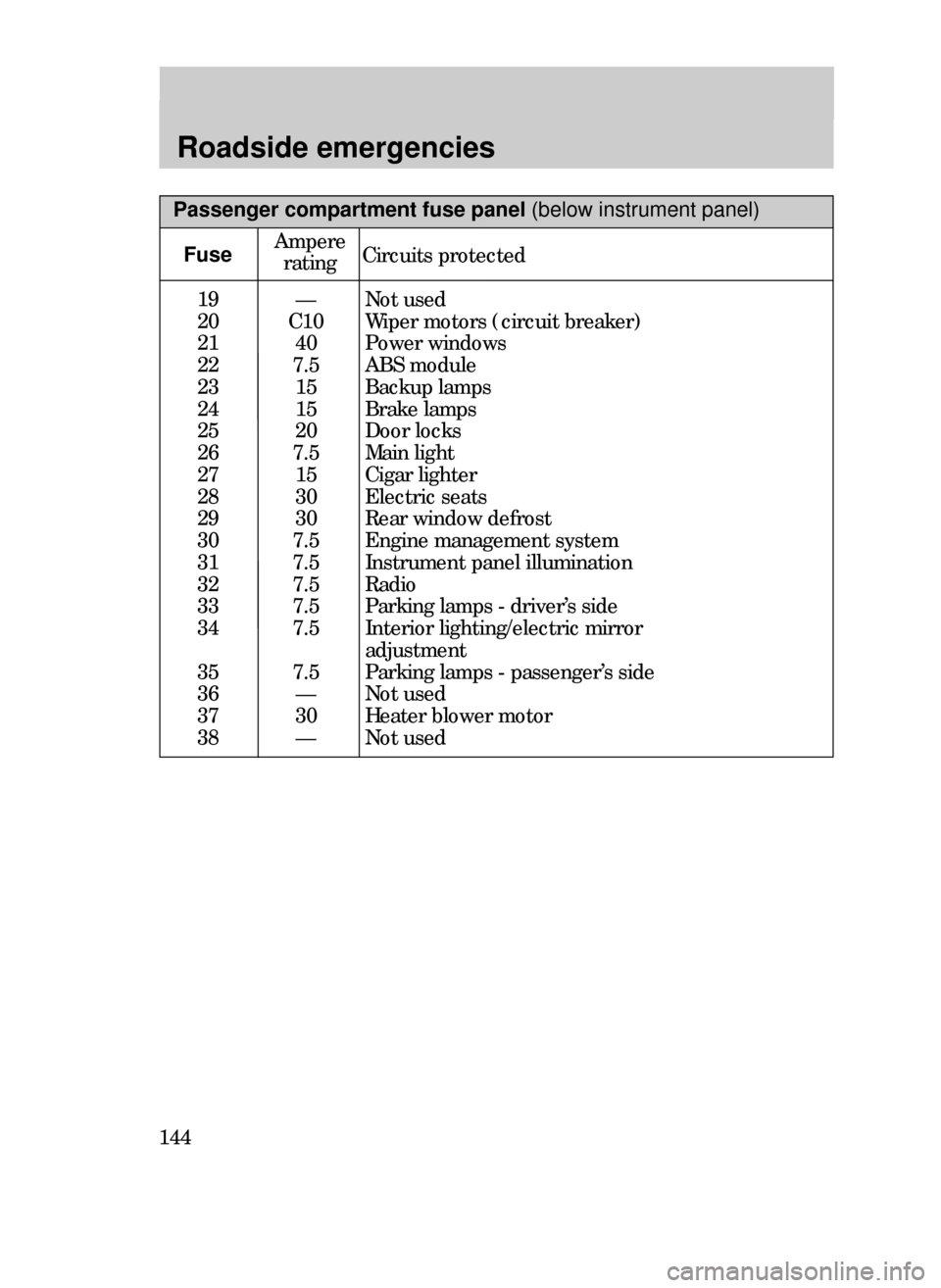
Roadside emergencies
144
19
20
21
22
23
24
25
26
27
28
29
30
31
32
33
34
35
36
37
38Ñ
C10
40
7.5
15
15
20
7.5
15
30
30
7.5
7.5
7.5
7.5
7.5
7.5
Ñ
30
ÑNot used
Wiper motors (circuit breaker)
Power windows
ABS module
Backup lamps
Brake lamps
Door locks
Main light
Cigar lighter
Electric seats
Rear window defrost
Engine management system
Instrument panel illumination
Radio
Parking lamps - driverÕs side
Interior lighting/electric mirror
adjustment
Parking lamps - passengerÕs side
Not used
Heater blower motor
Not used
Passenger compartment fuse panel (below instrument panel)
FuseAmpere
ratingCircuits protected
23CREen 3/25/99 3:35 PM Page 144
Page 145 of 244

Roadside emergencies
145
Fuse rating
7.5 amp
10 amp
15 amp
20 amp
30 amp
30 amp fuse link
40 amp
60 amp fuse link
80 amp fuse link
100 amp fuse linkColor
brown
red
light blue
yellow
light green
pink
orange
yellow
black
blue
Relay
R 18
R 20
R 21
R 22
R 23
R 24
R 25
R 26ÒOne touchÓ switch
(driverÕs window)
Not used
Not used
Foglamps
Turn signals
Panic alarm Ð
driverÕs side
Panic alarm Ð
right-hand side
Not usedDriverÕs door
Ñ
Ñ
Module bracket
Steering column
Door lock module bracket
Door lock module bracket
Ñ
Circuits switchedLocation
Standard fuse amperage ratings
and colors
3 amp violet
Auxiliary relays (outside of fuse boxes)
23CREen 3/25/99 3:35 PM Page 145
Page 146 of 244
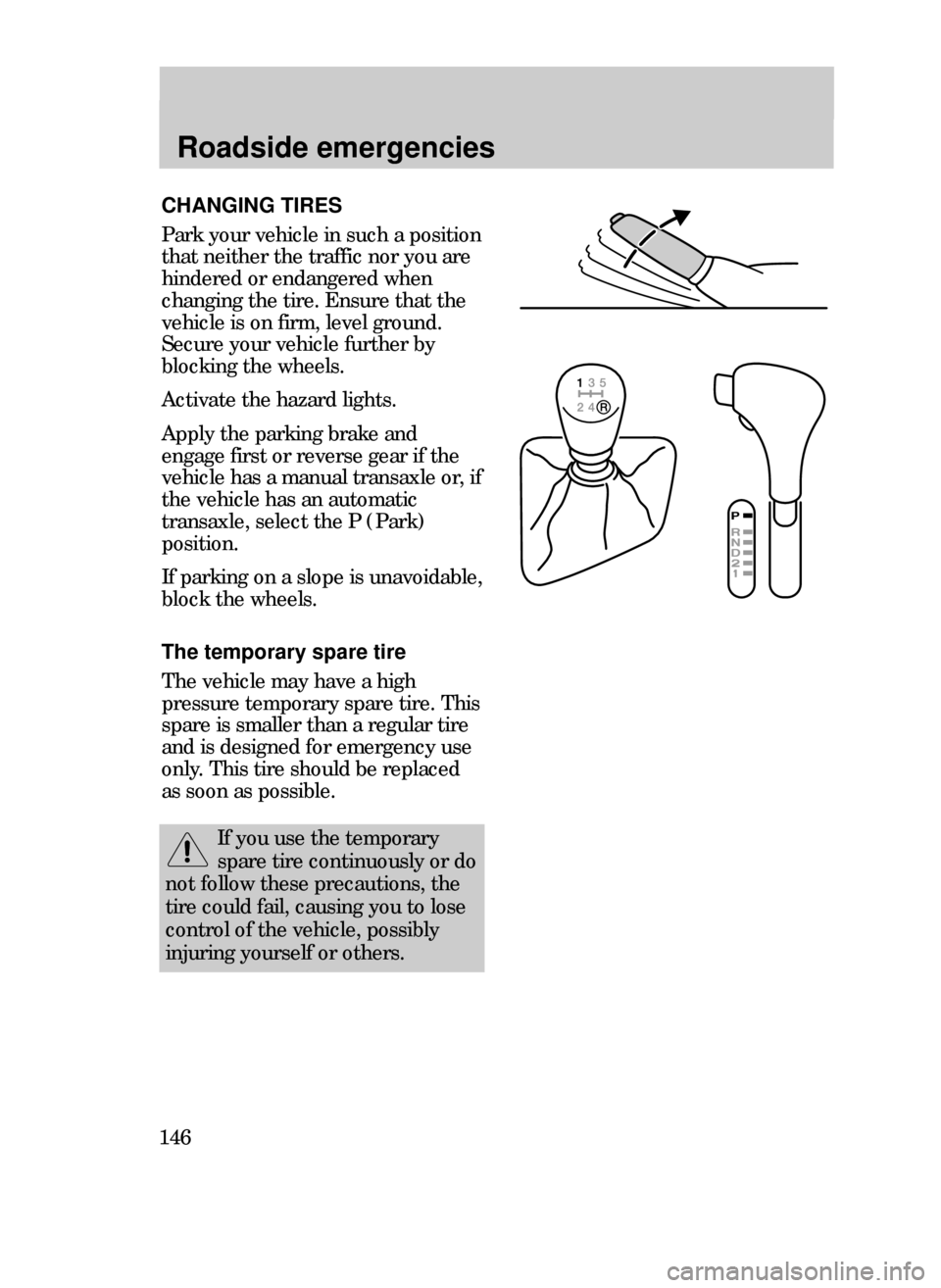
Roadside emergencies
146
CHANGING TIRES
Park your vehicle in such a position
that neither the traffic nor you are
hindered or endangered when
changing the tire. Ensure that the
vehicle is on firm, level ground.
Secure your vehicle further by
blocking the wheels.
Activate the hazard lights.
Apply the parking brake and
engage first or reverse gear if the
vehicle has a manual transaxle or, if
the vehicle has an automatic
transaxle, select the P (Park)
position.
If parking on a slope is unavoidable,
block the wheels.
The temporary spare tire
The vehicle may have a high
pressure temporary spare tire. This
spare is smaller than a regular tire
and is designed for emergency use
only. This tire should be replaced
as soon as possible.
If you use the temporary
spare tire continuously or do
not follow these precautions, the
tire could fail, causing you to lose
control of the vehicle, possibly
injuring yourself or others.
23CREen 3/25/99 3:35 PM Page 146
Page 147 of 244
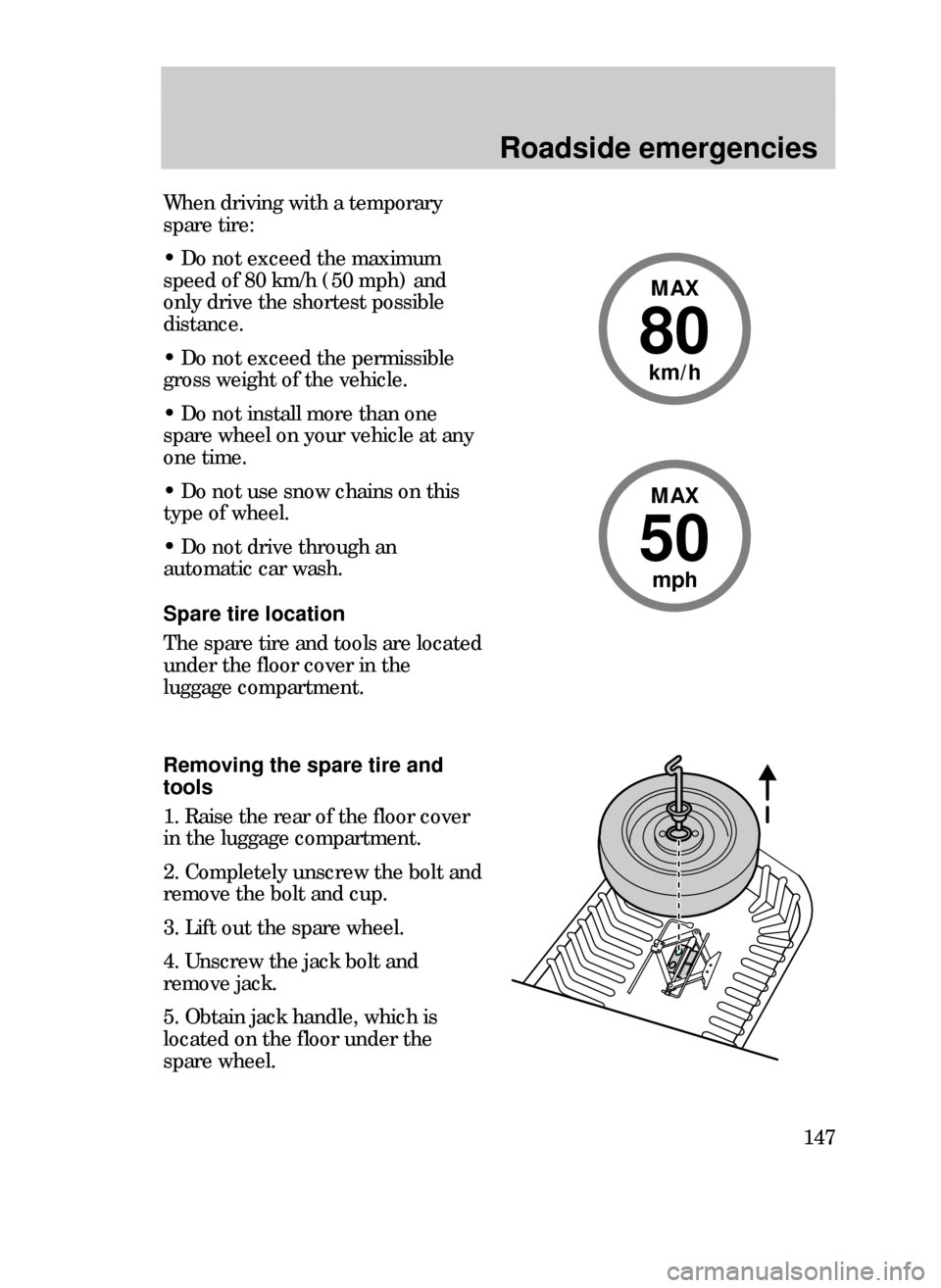
Roadside emergencies
147
80
MAX
km/h
When driving with a temporary
spare tire:
¥ Do not exceed the maximum
speed of 80 km/h (50 mph) and
only drive the shortest possible
distance.
¥ Do not exceed the permissible
gross weight of the vehicle.
¥ Do not install more than one
spare wheel on your vehicle at any
one time.
¥ Do not use snow chains on this
type of wheel.
¥ Do not drive through an
automatic car wash.
Spare tire location
The spare tire and tools are located
under the floor cover in the
luggage compartment.
50
MAX
mph
Removing the spare tire and
tools
1. Raise the rear of the floor cover
in the luggage compartment.
2. Completely unscrew the bolt and
remove the bolt and cup.
3. Lift out the spare wheel.
4. Unscrew the jack bolt and
remove jack.
5. Obtain jack handle, which is
located on the floor under the
spare wheel.
23CREen 3/25/99 3:35 PM Page 147
Page 148 of 244

Roadside emergencies
148
Removing a tire
1. Apply the parking brake and 1
(first) gear (manual transaxle) or
the P (Park) position (automatic
transaxle).
2. Activate the hazard flashers.
3. The driver and all passengers
must leave the vehicle.
4. Secure the vehicle against rolling
or sliding.
5. Insert the tapered end of the
jack handle between the rim and
hub cover and push in. Twist off to
remove the cover.
6. Loosen the wheel nuts slightly.
Tire changing procedure
7. Place jack with complete support
surface on the ground.
8. The jack must be applied exactly
vertical to the jacking point of the
vehicle.
9. Jack up the vehicle until the tire
is clear of the ground. Unscrew and
remove the wheel nuts and remove
the wheel.
23CREen 3/25/99 3:35 PM Page 148
Page 149 of 244
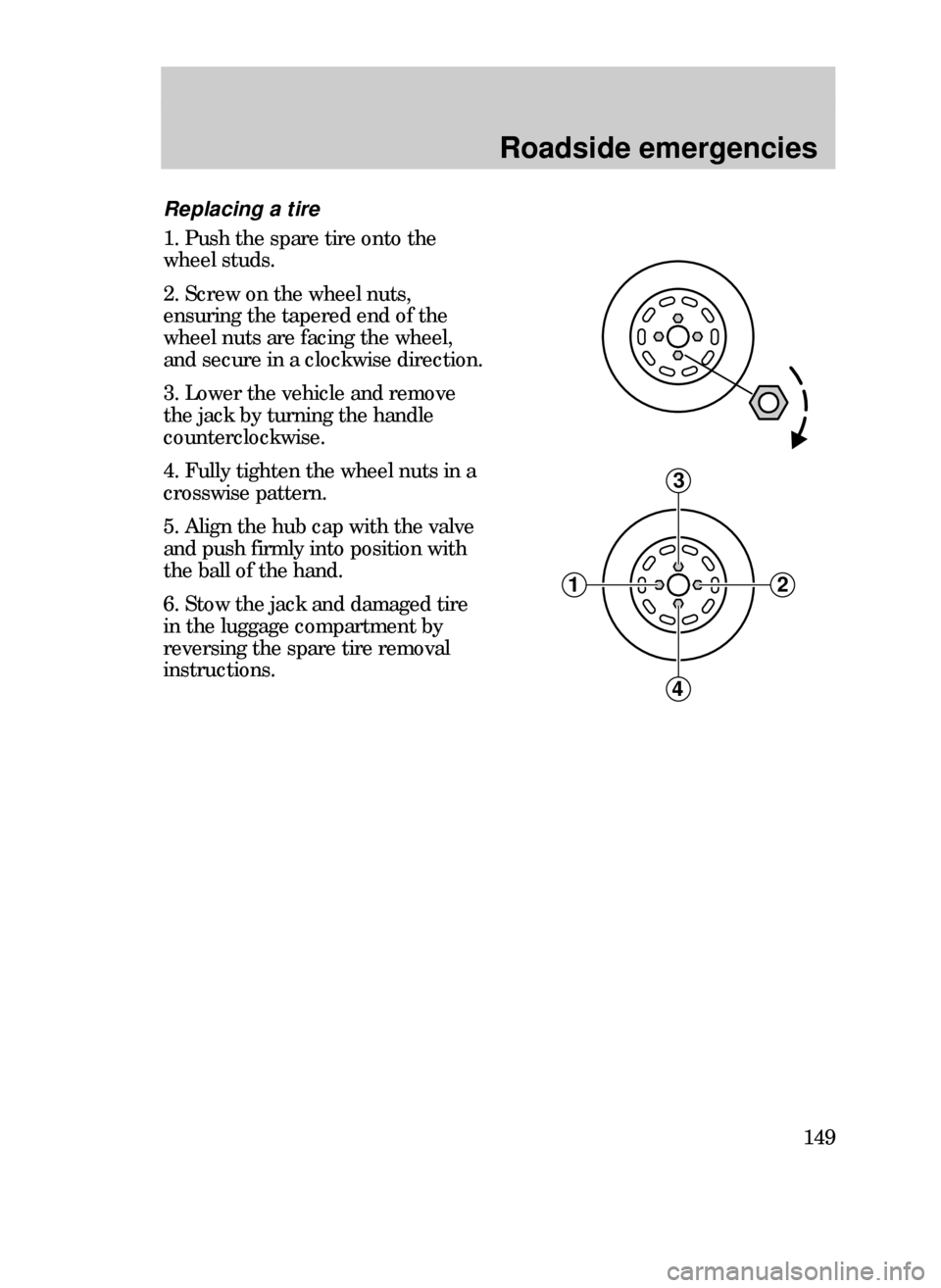
Roadside emergencies
149
Replacing a tire
1. Push the spare tire onto the
wheel studs.
2. Screw on the wheel nuts,
ensuring the tapered end of the
wheel nuts are facing the wheel,
and secure in a clockwise direction.
3. Lower the vehicle and remove
the jack by turning the handle
counterclockwise.
4. Fully tighten the wheel nuts in a
crosswise pattern.
5. Align the hub cap with the valve
and push firmly into position with
the ball of the hand.
6. Stow the jack and damaged tire
in the luggage compartment by
reversing the spare tire removal
instructions.
3
42 1
23CREen 3/25/99 3:35 PM Page 149
Page 150 of 244
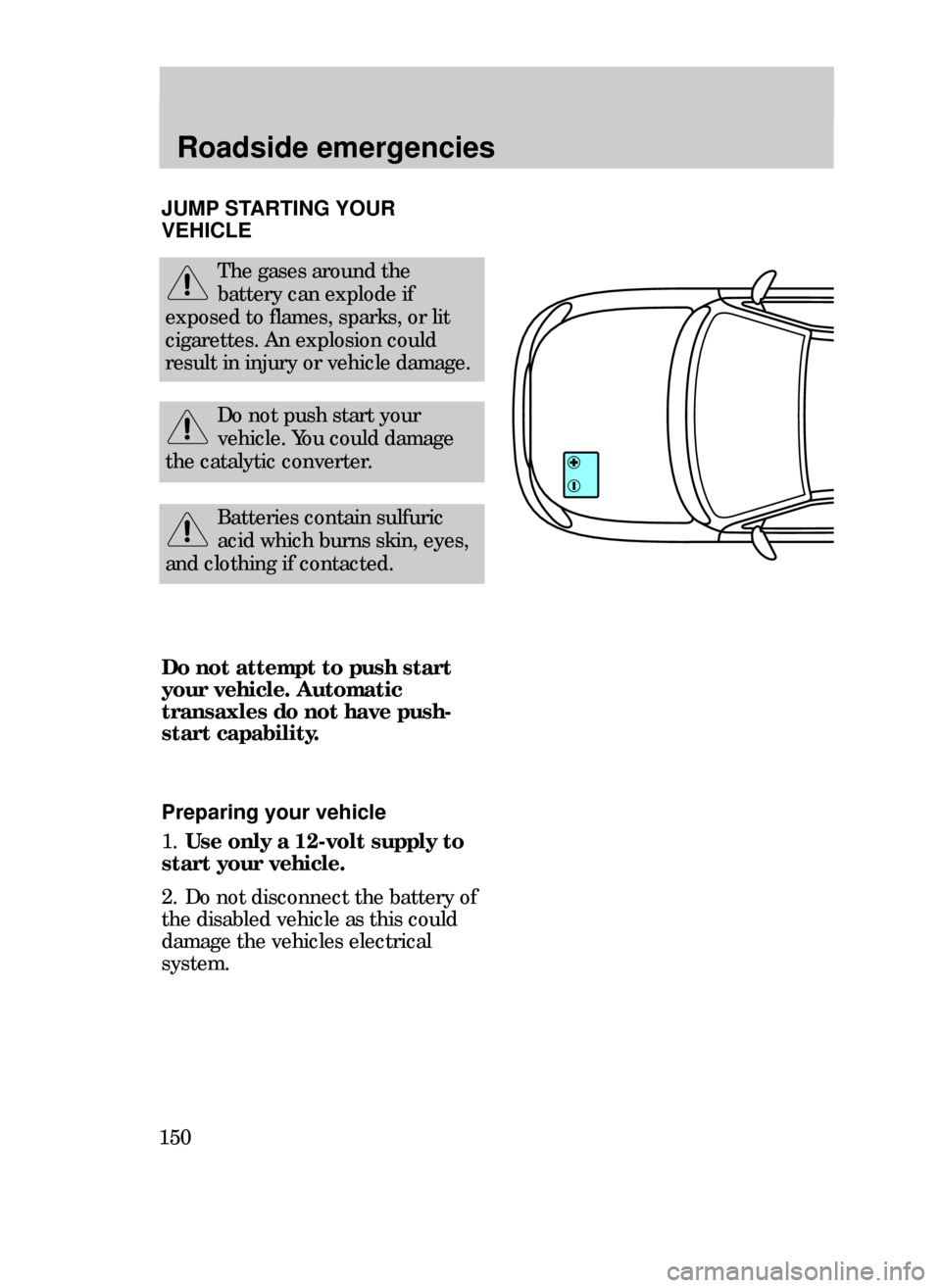
Roadside emergencies
150
JUMP STARTING YOUR
VEHICLE
The gases around the
battery can explode if
exposed to flames, sparks, or lit
cigarettes. An explosion could
result in injury or vehicle damage.
Do not push start your
vehicle. You could damage
the catalytic converter.
Batteries contain sulfuric
acid which burns skin, eyes,
and clothing if contacted.
Do not attempt to push start
your vehicle. Automatic
transaxles do not have push-
start capability.
Preparing your vehicle
1.Use only a 12-volt supply to
start your vehicle.
2. Do not disconnect the battery of
the disabled vehicle as this could
damage the vehicles electrical
system.
23CREen 3/25/99 3:35 PM Page 150